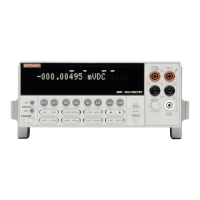IEEE-488 Reference
4-211
4.23 :TRACe subsystem
The commands in this subsystem are used to configure and control data storage into the buffer.
The commands are summarized in Table 4-31.
:TRACe|:DATA
The bar (|) indicates that :TRACe or :DATA can be used as the root command for this subsystem.
From this point on, the documentation in this manual will use :TRACe. If you prefer to use
:DATA, simply replace all the :TRACe command words with :DATA.
4.23.1 :CLEar [BUFFER,]
:TRACe:CLEar [BUFFER,] Clear buffer
Format :trac:cle
Table 4-31
TRACe command summary
Command Description Reference
:TRACe|:DATA
:CLEar [BUFFER,]
:FREE? [BUFFER,]
:EGRoup [BUFFER,] <name>
:EGRoup? [BUFFER,]
:POINts [BUFFER,] <n>
:AUTO [BUFFER,] <b>
:AUTO? [BUFFER,]
:POINts? [BUFFER,]
:FEED [BUFFER,] <name>
:PRETrigger
:AMOunt
[:PERCent] [BUFFER,] <n>
[:PERCent]? [BUFFER,]
:READings [BUFFER,] <n>
:READings? [BUFFER,]
:SOURce [BUFFER,]
<name>
:SOURce? [BUFFER,]
:CONTrol [BUFFER,] <name>
:CONTrol? [BUFFER,]
:FEED? [BUFFER,]
:DATA? [BUFFER,]
Use :TRACe or :DATA as root command.
Clear readings from buffer.
Query bytes available and bytes in use.
Select element group: FULL, COMPact.
Query element group.
Specify size of buffer.
Enable (1 or ON) or disable auto buffer sizing.
Query state of auto buffer sizing.
Query buffer size.
Select source of readings: SENSe[1], CALCulate[1], NONE.
Path to configure pre-trigger storage mode.
Path to specify number of pre-trigger readings.
Specify as a % (0 to 100) of buffer.
Query percentage.
Specify as a number.
Query number of readings.
Select pre-trigger source event:EXTernal,
TLINk, BUS, MANual.
Query pre-trigger source event.
Select buffer control mode:NEVer, NEXT, ALWays, PRETrig-
ger.
Query buffer control mode.
Query source of readings for buffer.
Read all readings in the buffer.
4.23.1
4.23.2
4.23.3
4.23.4
4.23.5
4.23.6
Notes:
1. Brackets ([ ]) are used to denote optional character sets. These optional characters do not have to be included in the program message. Do not use brack-
ets ([ ]) in the program message.
2. Angle brackets (< >) are used to indicate parameter type. Do not use angle brackets (< >) in the program message.
3. Upper case characters indicate the short-form version for each command word.

